Are you a golf enthusiast looking to improve your swing? Whether you’re just starting or have been playing for years, mastering the golf swing is essential for achieving accuracy, distance, and consistency.
A perfect golf swing requires a combination of proper grip, posture, alignment, and technique. In this blog, we guide you through the critical components of a golf swing, provide tips to help you perfect your swing mechanics, and offer advice for swinging different golf clubs.
By the end of learning how to swing a golf club, you’ll be well-equipped with the knowledge and tools to swing with precision and confidence. Let’s dive in!
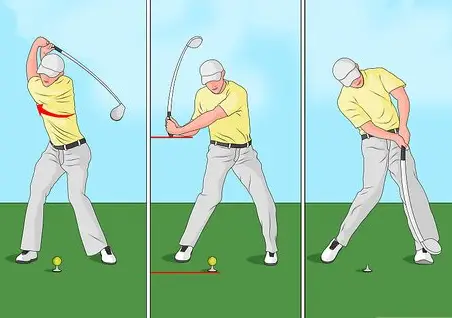
- Grip: Hold the club with a neutral grip, ensuring hands work together.
- Stance: Stand with feet shoulder-width apart, knees slightly flexed.
- Backswing: Rotate shoulders while keeping arms extended for a smooth takeaway.
- Downswing: Lead with the hips, keeping hands ahead of the clubface at impact.
- Follow-Through: Rotate fully toward the target, finishing in balance.
Jump To Section
ToggleUnderstanding the Basics of a Golf Swing
When perfecting your golf swing, understanding the basics is crucial. Begin by aligning your body with the target and taking a comfortable stance. Position the golf club properly and grip it with the correct pressure to ensure control and power.
Your left foot should be positioned correctly, and your right foot should follow. Maintaining the proper posture sets the stage for a perfect golf swing. Understanding these fundamental elements will lay the foundation for executing a successful swing and achieving good shots on the golf course.
If you’re new to golf and just learning how to swing a golf club, start with the basics. These tips are perfect for beginners. They can help you enhance your takeaway, an essential part of any good golf swing. Once you’ve mastered these basics, your golf swing will be perfect in no time!
Importance of a Proper Golf Grip
Maintaining control of the golf club head is crucial for a successful swing, making the proper grip essential. One common type is the interlocking grip, favored by many golfers. Your left hand’s grip must overlap with your right hand.
This connection helps ensure that the club’s face is square at impact. A firm yet not overly tight grip allows for a smooth and fluid motion when swinging the golf club, resulting in better control and more consistent shots.
It’s essential to achieving a perfect golf swing, especially for beginners looking to improve their game.
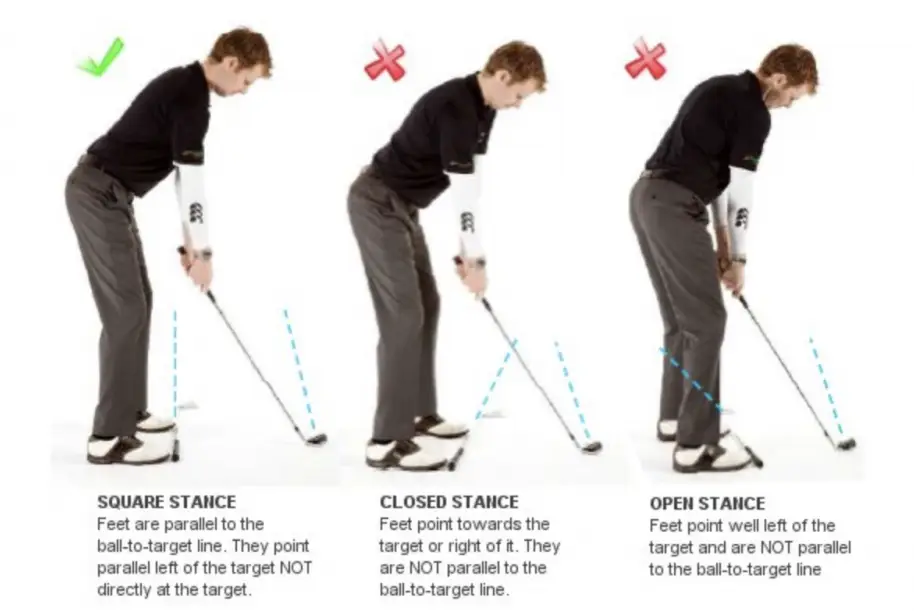
Perfecting Your Golf Posture
Maintaining an optimal spine angle is crucial when perfecting your golf posture. Proper upper body positioning is essential to establish a sturdy foundation for your swing, ultimately leading to improved accuracy and power in your shots.
Additionally, achieving a well-balanced weight distribution, with a slight emphasis on the front foot, contributes to a more controlled and effective swing. Focusing on these aspects can enhance your posture, resulting in a more consistent and reliable performance on the golf course.
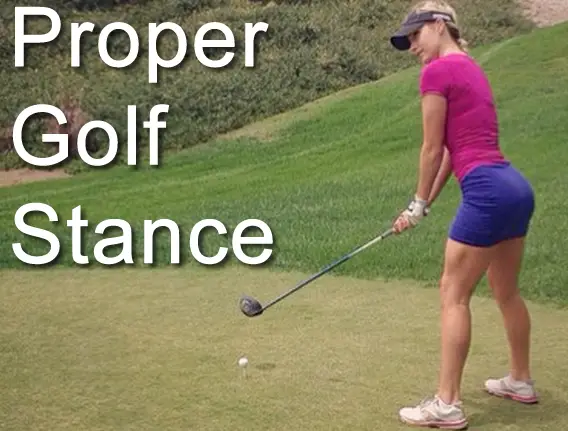
Aligning for the Perfect Swing
The perfect golf swing starts with aligning your body and the club correctly. The position of your left foot determines your alignment, ensuring it points toward the target.
The golf club should also align with the target, following the direction of your feet. Your right foot should align with your left foot for a balanced stance.
The index finger of your left hand must make direct contact with the top of the grip, while your right hand should hold the bottom of the club. Also, your right shoulder must align parallel to the target line.
Adapting these alignments can significantly improve your chances of hitting good shots and mastering the perfect golf swing, especially for beginners. Using these methods can help you improve your golf swing.
Factors Affecting Alignment
Proper alignment of your body ensures optimal swing rotation, leading to the right clubface angle that impacts your shot’s direction. Your front foot’s alignment and the angle of the clubface significantly influence your shots, affecting the golf ball‘s trajectory.
Achieving the target line relies heavily on the correct alignment of your body and clubface, ultimately influencing the outcome of your shots.
Additionally, a precise alignment guarantees that your shot follows the desired trajectory, resulting in consistently good shots on the golf course.
Techniques to Improve Alignment
Try visualizing your target line before taking a swing to improve your alignment. Focus on your setup posture, which is crucial in enhancing alignment.
Practice drills that specifically target alignment to refine your golf swing. Using alignment sticks during practice can aid improvement by providing a visual reference for your alignment.
To perfect your swing alignment for more accurate shots, use alignment aids during practice. Implementing these techniques can refine your alignment and result in a consistent golf swing.

Mastering the Backswing
When mastering the backswing, key components play a crucial role. The takeaway left thumb position and proper shoulder movement significantly impact your swing.
Beginners often struggle with finding the right balance between these elements, resembling a baseball bat swing rather than a golf club swing. The correct positioning of the left hand, alignment with the target, and the backswing shaft angle are also pivotal for executing good shots consistently on the golf course.
Developing an excellent way to overlap your left thumb with your right knuckles, like holding a baseball bat, can help achieve a perfect golf swing.
Critical Components of a Good Backswing
A fundamental aspect of a strong backswing is executing a full upper-body rotation, ensuring that the arc aligns with the swing plane for consistency. A proper wrist hinge is pivotal in generating power, while maintaining the spine angle throughout is equally crucial for a good backswing.
Initiate the backswing with a rotational movement of the torso, allowing for a seamless transition into the subsequent phases of the swing. These key components collectively contribute to a well-executed backswing, setting the stage for a powerful and effective golf shot.
Common Backswing Mistakes and How to Avoid Them
Turning too much during the backswing can mess up your shots and how you play overall. It’s important not to move your arms too much during the backswing because it can mess up your swing and your shots’ power and accuracy.
Keeping your posture during the backswing helps avoid alignment problems and ensures your swing is consistent and effective. Swinging the club too far inside during the backswing can mess up your swing arc and lead to bad results.
If you want to swing well, don’t rush your backswing. Take your time to make sure your downswing is smooth and controlled. This helps your shots be more powerful and accurate.
These tips are good for beginners who want to get better at golf and hit good shots more often.

Executing the Downswing
When bringing down the club, shift your weight to the left foot and start rotating your hips. Keep the grip pressure light and let the club drop.
Your index finger of the bottom hand should maintain contact with the grip. Lead with the lower body, closely resembling the motion of a baseball bat swing.
Rotate your right foot and prevent it from rolling too much. The club head should follow a path that lags behind your hands, resulting in good shots.
Focus on bringing the club down on the right plane and strike the ball with the right shoulder.
Timing and Technique in a Downswing
Timing and technique in a downswing are critical for a successful golf swing. Precise timing and coordinated body movements are essential during this phase.
The weight transfer from the back foot to the front foot plays a crucial role, ensuring a fluid and balanced rotation of the body. Maintaining a consistent spine angle is essential for proper downswing technique.
Additionally, achieving a shallow swing plane is vital to an effective downswing. Incorporating these elements into your downswing can lead to more consistent and powerful shots on the golf course, especially for beginners looking to perfect their golf swing.
Downswing Errors and Their Solutions
Golfers often make mistakes when they swing down that can mess up their shots. If your swing is over-the-top, try focusing on swinging from inside to outside for a smoother motion.
If you’re casting the club when you swing down, try releasing the club later for a more controlled swing. But if you’re slicing when you swing, try to improve your grip and how you rotate your body.
This can also help your overall swing. Another problem to avoid is standing up too early. To prevent this, keep your posture during the downswing.
Finally, making sure you smoothly go from the backswing to the downswing can help fix common mistakes and lead to better, more consistent shots.
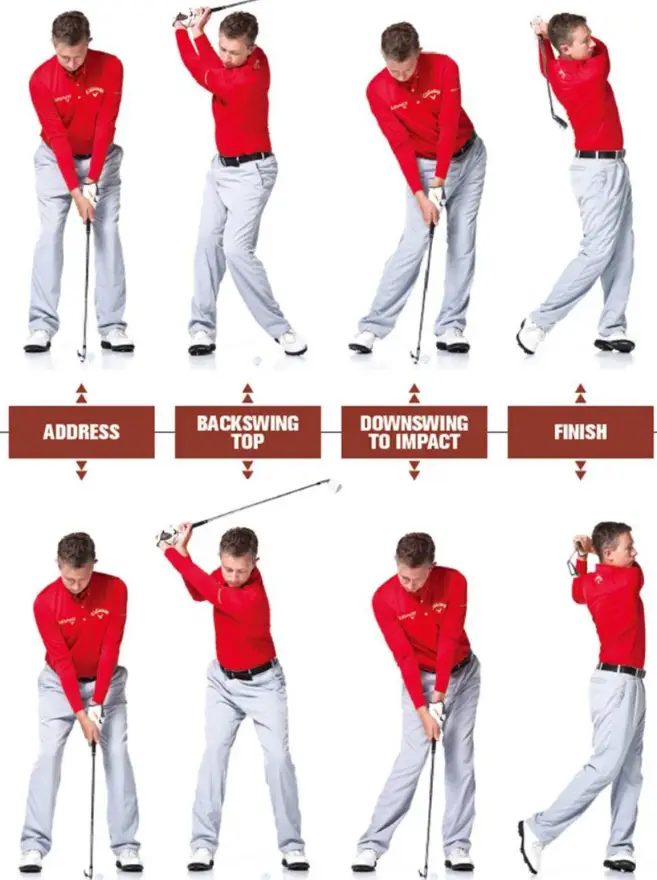
The Follow-Through: An Essential Part of the Golf Swing
The follow-through is a crucial component of the golf swing, often determining the success of your shot. It involves extending your arms and rotating your body after making contact with the ball.
You can achieve a balanced finish by pivoting on the left foot and lifting the right heel. The direction of your club after impact indicates the quality of your shot.
To swing a golf club well, you need to focus on the complete motion. This includes the takeaway and follow-through. A good follow-through improves accuracy and leads to straight shots.
It also enhances overall golf performance. Beginners must learn this seamless, powerful stroke to execute a perfect golf swing.
Role of the Follow-Through in a Golf Swing
In golf, the follow-through is crucial for achieving a full release of the club head, optimizing both distance and control. A good follow-through is synonymous with a smooth and efficient swing arc, ultimately enhancing the overall mechanics of the swing.
Maintaining balance and body alignment post-impact during the follow-through is imperative. This phase not only reflects the golfer’s swing plane, tempo, and rhythm but also completes the swing, significantly influencing the shape and spin of the shot.
To perfect your golf swing and consistently hit good shots, it’s crucial to embrace the follow-through. Beginners should focus on this aspect.
Tips to Enhance Your Follow-Through
To enhance your follow-through, focus on extending the golf club down the target line, ensuring a balanced weight shift onto the front foot. A relaxed grip and wrist hinge contribute to a smooth, natural follow-through, improving shot consistency.
Visualize the ball target line as your swing arc extends through impact, guiding the follow-through. Consistently practicing a complete follow-through refines ball striking, leading to good shots and a perfect golf swing.
Embracing these techniques, beginners can ensure an excellent way to adapt their swing to different clubs, enhancing their overall performance on the golf course.
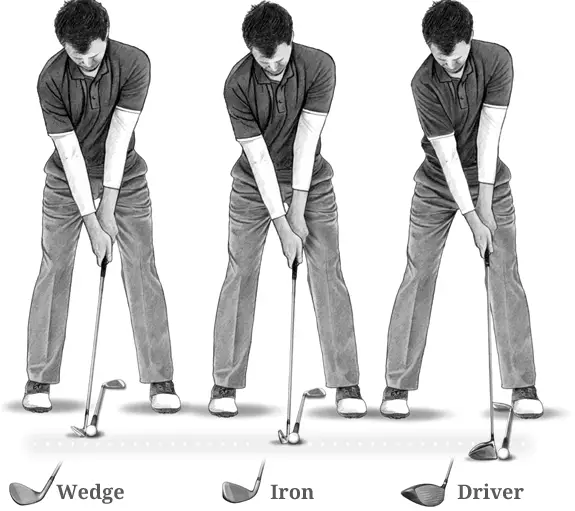
Swinging Different Types of Golf Clubs
Different golf clubs need different swings. Irons and drivers each need a unique swing style. Changing your swing for each club can improve your shots.
With irons, hit the ball before the ground. With a driver, hit the ball while swinging upwards for more distance. It’s hard for beginners, but with practice, you can master swinging all types of golf clubs.
Knowing how to swing each club helps you play better and more consistently.
Differences in Swinging Irons and Drivers
Swinging irons and drivers need different techniques for the best game. Iron swings need to hit the ball first with a steep swing for good shots. But drivers need a sweeping, upward swing for the best launch and distance.
Iron shots need a downward hit for accuracy, while drivers need an upward hit for distance. The setup, ball position, and swing angle change a lot between irons and drivers, so golfers need to change their swings.
Knowing these differences is important for golfers, especially beginners, to get their golf swing right for good shots.
Adapting Your Swing to Different Clubs
When you switch clubs, you need to change your swing speed and angle. Shorter clubs like wedges need a steeper swing than longer clubs like Woods.
Changing your swing means adjusting your grip, hand position, clubface direction, and swing path. Knowing the best speed and swing for each club can make your shots more accurate and go farther.
These changes are important for learning to swing different clubs well, which helps you play consistently in different situations.
Additional Tips for Improving Your Golf Swing
Enhance your stance by positioning your left foot at the width of your shoulders and your right foot slightly flared out. Use a baseball grip, overlapping your left thumb with your left index finger and placing your right hand’s little finger between the index and middle finger of your left hand.
Maintain your left arm straight, and start your backswing using a one-piece takeaway motion to achieve a seamless swing. Focus on keeping your right elbow close to your body and your left shoulder in a good way during the backswing for better control.
Additionally, focus on the knuckles of your top hand and the index finger of your bottom hand to perfect your golf swing.
The Role of Practice and Consistency
Practicing a lot helps you learn how to swing and build muscle memory. Consistent swing speed, grip, and stance affect how you hit the ball and control your shots.
Regular practice helps you improve your swing and make it more consistent. Practicing different positions and clubs improves your skills and adaptability.
Also, practicing regularly builds confidence and trust in your swing. A routine that includes these things helps you improve your golf swing and get better results when you play.
Embracing Progressive Learning and Improvement
To enhance your golf swing, begin by mastering the basics of grip, stance, and alignment. Consistent practice and repetition are crucial for developing a reliable and effective swing.
Focus on maintaining proper body positioning and transferring weight smoothly during each swing. Seeking feedback from a golf instructor and utilizing video analysis can help refine your technique.
Embrace a growth mindset to seek opportunities for learning and improvement continuously. By staying open and receptive to ongoing progress, you can effectively enhance your skills and elevate your performance on the golf course.
Embracing progressive learning and improvement is an excellent way to perfect your golf swing.
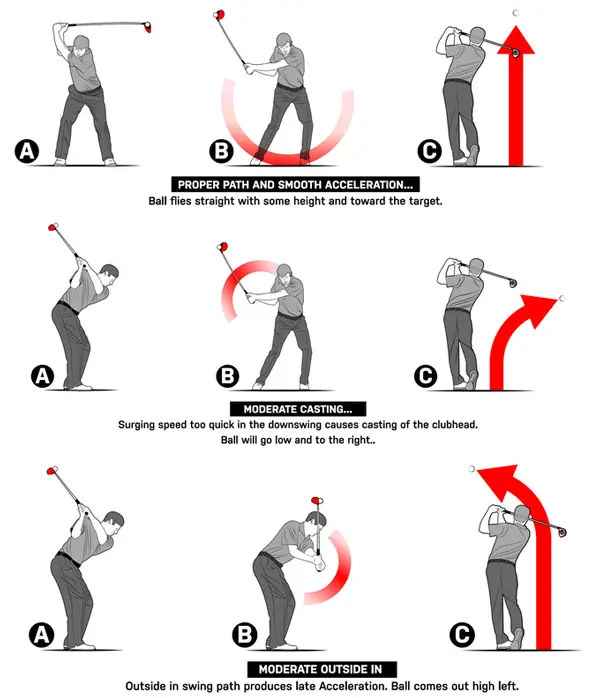
Why is the Golf Swing So Challenging to Perfect?
Mastering the golf swing is challenging due to its complex movement pattern, requiring coordination and precision. Minor technique errors can significantly impact the outcome. Grip, stance, and alignment all contribute to the challenge. Consistent practice and feedback from a coach are crucial for improvement.

Conclusion
In conclusion, mastering the art of a perfect golf swing requires a combination of technique, practice, and consistency. By understanding the basics of a golf swing, such as the importance of a proper grip and posture, you can lay a solid foundation for your swing.
Aligning your body correctly and executing a smooth backswing and downswing are essential for a powerful and accurate shot. Don’t underestimate the role of the follow-through, as it helps maintain balance and control throughout the swing.
Remember that different clubs may require slight adjustments in your swing technique. Lastly, embrace the challenges and enjoy the learning process, as improvement in your golf swing is a journey.
So get out on the course, practice regularly, and watch your swing soar to new heights!
Previously: Best Golf Balls for Mid Handicappers: Top Picks for 2025
Next up: How Much Do Golf Lessons Cost? A Complete Pricing Guide






